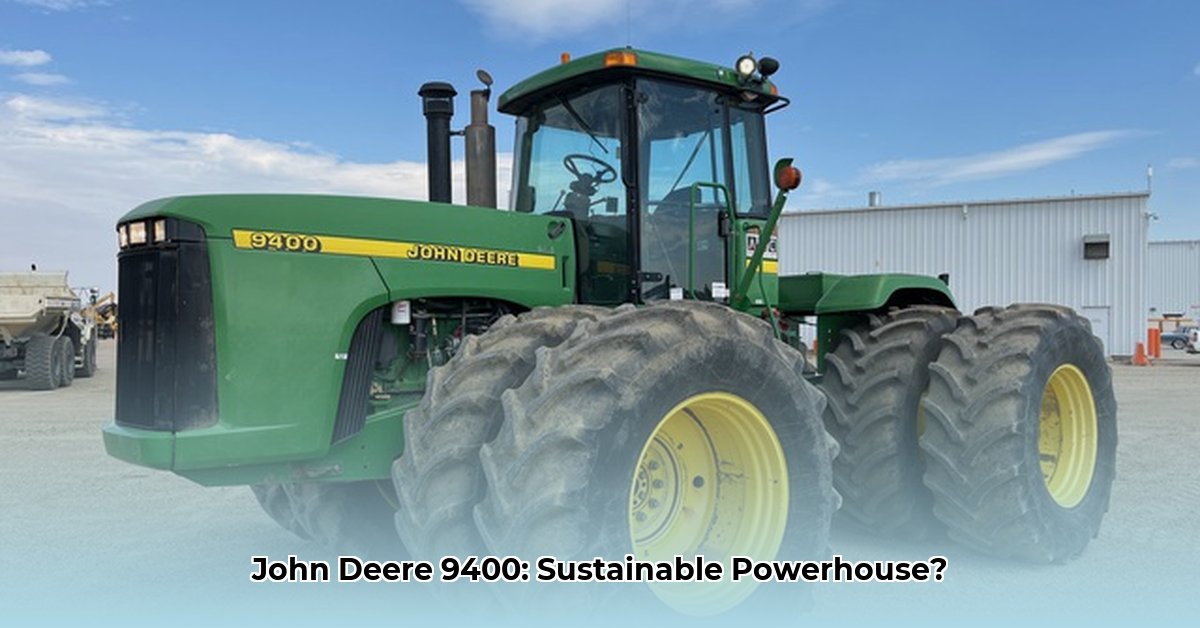
The John Deere 9400 tractor holds a legendary status in agricultural history. Its potent 425 horsepower engine revolutionized farming, enabling unprecedented efficiency. However, evaluating its legacy requires a critical examination of its sustainability performance against modern standards. This review delves into the 9400's specifications, comparing its capabilities to contemporary tractors, and assessing its environmental impact. For more information on John Deere manufacturing locations, see this helpful resource.
9400 John Deere Tractor Specs: A Sustainability Deep Dive
The 9400's power was a game-changer. Farmers could accomplish more swiftly. Transmission options, ranging from partially synchronized to full power shift (providing 12 or 24 speeds), offered flexibility for various tasks. This potential for optimized fuel economy, depending upon the application, represented a notable technological leap. But how do these features translate to modern sustainability criteria?
The Data Puzzle: Fuel Use and Emissions
A critical limitation in assessing the 9400's sustainability is the scarcity of data on fuel consumption per acre and greenhouse gas emissions. This lack of information severely hinders a comprehensive environmental impact analysis. Without this crucial data, a complete evaluation remains impossible.
Beyond its Working Life: The End-of-Life Question
Another significant gap in our understanding concerns the 9400's end-of-life management. The recyclability of its components and the ease of proper disposal are unknown. This absence of information prevents a holistic assessment of its sustainability. Modern sustainable agriculture emphasizes circular economy principles; without data on the 9400's recyclability, we cannot gauge its adherence to these principles.
Modern Comparisons: How Does the 9400 Measure Up?
Comparing the 9400 to modern tractors requires analyzing several key performance indicators (KPIs). These include fuel efficiency (gallons per acre or liters per hectare), greenhouse gas emissions (tons of CO2 per ton of yield), and overall lifecycle impact scores. A thorough comparison, however, is currently hampered by the absence of complete 9400 data, particularly regarding emissions.
Charting a Sustainable Course: Actionable Steps
Addressing sustainability challenges in agriculture requires a multi-pronged approach:
| Stakeholder | Short-Term Actions | Long-Term Actions |
|---|---|---|
| Farmers | Implement precision farming techniques; monitor fuel consumption diligently. | Transition to precision agriculture for optimized land and fuel use; investigate alternative fuels (biodiesel, etc.). |
| Manufacturers | Conduct comprehensive lifecycle assessments (LCAs) of existing models. | Prioritize fuel efficiency and recyclability in new designs; invest heavily in R&D for sustainable technologies. |
| Policymakers | Offer financial incentives for equipment upgrades and sustainable practices; create robust recycling programs. | Establish stringent emission standards; allocate substantial funding for sustainable agricultural research and development. |
Mitigating the Risks: A Risk Assessment Matrix
Older equipment like the 9400 presents several risks:
| Risk Factor | Potential Impact | Mitigation Strategies |
|---|---|---|
| High Fuel Consumption | Increased greenhouse gas emissions; elevated operating costs. | Adopt fuel-efficient practices; explore alternative fuels. |
| End-of-Life Management | Environmental pollution; wasted resources. | Develop efficient recycling and component reuse programs. |
| Parts Availability | Difficulty sourcing parts; reduced operational efficiency. | Develop robust parts supply chains; explore part-sharing initiatives. |
The lack of readily available emissions data on the 9400 severely restricts a comprehensive assessment of its environmental compliance. Further research is critical to address these data gaps. While the John Deere 9400 showcased impressive power for its time, its sustainability profile remains incomplete. A holistic approach to farm sustainability that examines the entire equipment lifecycle is crucial for the future of agriculture.
How to Calculate John Deere 9400 Tractor Fuel Efficiency Per Hectare
Precisely calculating the 9400's fuel efficiency requires a practical approach, considering that published fuel consumption rates often represent idealized scenarios. Factors like soil conditions and terrain greatly influence actual fuel usage.
Calculating Fuel Efficiency: A Step-by-Step Guide
Measure Fuel Consumption: Record the initial and final fuel tank levels to determine total fuel used.
Track Work Time: Accurately time the operation.
Determine Area Covered: Precisely measure the area worked using GPS or field maps (in hectares).
Calculate Fuel Consumption per Hectare: Divide total fuel consumption by the area covered.
Optional Normalization: For a broader comparison, calculate consumption per hectare per horsepower-hour. (This may require estimations of average horsepower utilization).
Comparing the John Deere 9400: A Sustainability Perspective
While the 9400's fuel consumption likely exceeds that of modern tractors, it's crucial to also consider its work capacity. A more fuel-efficient tractor performing less work might not be ultimately more efficient. Precision agriculture techniques significantly enhance fuel efficiency.
Key Takeaways:
- Accurate fuel consumption data requires meticulous record-keeping.
- Fuel efficiency varies widely depending on operational conditions.
- Comparing the 9400 to modern tractors necessitates considering both fuel efficiency and work output.
- Precision agriculture drastically reduces fuel usage and improves sustainability.
- The initial investment in new equipment or precision agriculture technologies needs to be weighed against the long-term benefits.